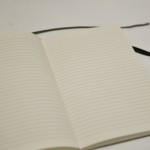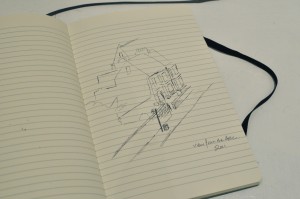 Show me a writer who doesn’t appreciate nice stationery and I’ll show you a baker who doesn’t like cake. People who write love their tools, and nothing gets the heart racing like a new notebook. The promise in the empty lines, the smell of pristine paper, and the smooth feel of unmarked pages; before you write a word there’s a writing future where you didn’t screw it up and you’re not a complete failure as a person. (Show me a writer who never thinks that and I’ll bake you a cake myself.)
Show me a writer who doesn’t appreciate nice stationery and I’ll show you a baker who doesn’t like cake. People who write love their tools, and nothing gets the heart racing like a new notebook. The promise in the empty lines, the smell of pristine paper, and the smooth feel of unmarked pages; before you write a word there’s a writing future where you didn’t screw it up and you’re not a complete failure as a person. (Show me a writer who never thinks that and I’ll bake you a cake myself.)
But this is why the beauty of the new notebook is also the horror. What if you write a terrible sentence? What if you have to cross things out, make spelling mistakes, use a pen that bleeds? What if you do all the usual horrible things you do when you write because you are imperfect, and a learner, and you can’t craft a beautiful sentence at all? Why bother when you are not Chekhov? Why write when you can’t be brilliant?
And so there the notebook sits, gathering dust instead of thoughts.
It’s the love getting in the way. Did you know that? The love you have for the words, and the way the great ones make you feel, gets twisted into a peculiar reverence for the special pen, the vintage Corona typewriter, the paper that everything is written on, until you come to understand that you are so unworthy you shouldn’t be touching these things until you are a better writer.
Here’s the thing: you will never be good enough. You will certainly never be good enough if you don’t write, but even then…
It’s true. You may as well accept it. You have an ideal in your own head, and you’ll never be quite as good as you wish you were, because no one is. It may be that in among the writing you do today you find one perfect sentence, and you will feel like a giant for a split second until you look at all your other sentences, but this is a common feeling among writers.
I have one trick to offer you, to get you to open that new Moleskine and start writing:
Open the book in the middle, and draw a picture.
It doesn’t matter if you can’t draw. Draw a self portrait. Draw the cat. Draw the house you wish you had. Draw your favourite ever shoes. Draw the view from the window. It’s important to draw because it isn’t writing. It’s not about words, and getting your craft right. It’s about spoiling the notebook and clearing the mental barriers you’ve set up. Look – here’s mine:
Now the notebook is effectively ruined, you might as well put some words in it.


Oh, Jo, you have hit the nail on the head. That bit about the ideal. What a miserable bastard is that smug puff of wind. I don’t have the notebook jinx because … I wrote with pencils!! You can erase. Trouble is, I can’t read it back weeks later. “your handwriting’s like barbed wire,” moaned my Latin teacher. I also live Moleys, but the plain ones. Don’t know why. Have to be plain. Maybe for sad little drawings which get spoiled by lines and pencil not strong enough to overcome. Sm sure YOUR drawing not dismal, but phone screen to see. Here’s commitment to a blog post, typing a comment on an unreliable bloody phone
Commitment indeed! I am too concerned with neatness to allow myself a plain notebook. Lines all the way – can’t bear the way my writing slopes without them.
Sometimes just having written something, anything, is enough, never mind that you can’t read it (and how rude of your Latin teacher!). A lot of the time I start by getting my daily moans of inadequacy down on paper, and heaven knows I don’t need to read those over, especially considering I write them anew every day.